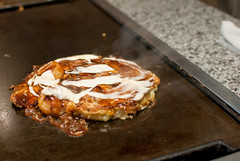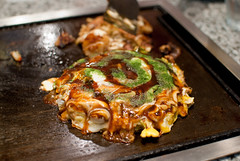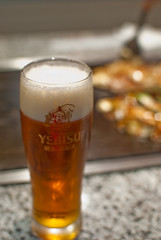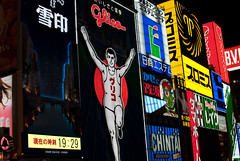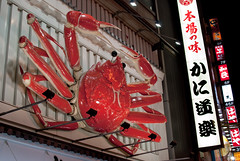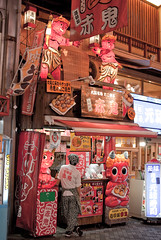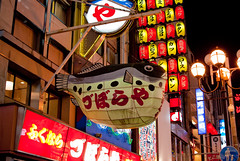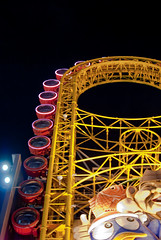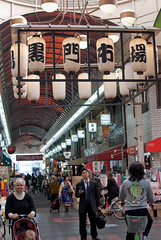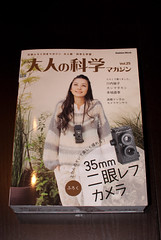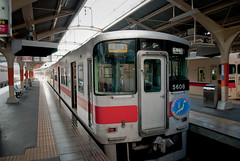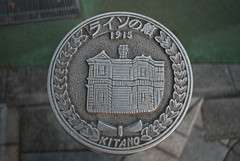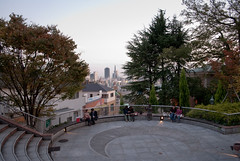After an afternoon break back at the hotel, we headed back out into the town. A great area just hang around at night would be Dotonbori [道頓堀]. It's at the southern end of the Shinsaibashi-suji shopping arcade. You know you've reached Dotonbori when you see all the bright lights and giant neon advertisements lined up right next to the tiny river.
However, our highlight tonight was not the touristy stuff, but our dinner. We found an okonomiyaki restaurant that was recommended by one of N's travel books. To a foreigner, you probably wouldn't pick this restaurant out except for the crowd lining outside the door. At first, I thought the restaurant was really tiny with only 10 seats right up against the cooking area. The cooks literally cook the okonomiyaki on the giant flat grills right in front of you. It's pretty neat to see it all, and to smell it all.
Originally, I thought the staff were trying to tell us that the wait would be another 1.5 hours and were asking us to come back. However, as we were making our way out of the restaurant, the server rushed out and grabbed us and redirected us upstairs. Upstairs? I didn't realize there was an upstairs here. Upstairs actually had tables with mini-grills in the middle. Good thing the server came out to grab us; otherwise, we would've missed this great meal.
I felt that the occasion called for a glass of local brew. Yebisu was the brand they were pedalling so I decided to partake in it. It was a light lager type of beer, but it was pretty tasty. I'm not a huge light beer fan, but this one was definitely a good one. We ordered a set meal consisting of two mini-okonomiyakis and one regular, larger okonomiyaki.
After dinner, there was a really long line up. We were glad that we had gotten a littler early to the restaurant. Otherwise, we'd really be waiting 1.5 hours for dinner. We went back to the Dotonbori Bridge and took in the giant adverts. Even if you don't plan on spending any money, it's great just to stand and bask in the glow of the commercial lights and watch tourists pose as their favourite snack brand athlete, the Glico Man.
The bright Dotonbori River lights are not the only draw on this stretch. There's also many larger than life store signs along the pedestrian walk that is directly south of the river and runs parallel to the river. Right on the corner of the pedestrian walk and the Dotonbori bridge is a giant crab. It simply dominates this particular corner. Obviously, the restaurant on which this sign resides sells crab for dinner. Go figure.
A little further down, there is a variety of other signs. There's the Red Devil Takoyaki stand complete with red demons adorning the whole front. There's a giant lit up puffer fish with giant "fugu" hiragana letters noting the presence of a fugu restaurant. (Every year, a handful of people die eating the poisonous puffer fish). There's also a Dotonbori icon that looks like a Japanese man with thick round glasses wearing a clown suit decked out in American colours. A famous landmark and icon to Japanese, but it's not really accessible to those who do not speak Japanese.
We then headed back to river and walked along the quieter riverwalk. There was a lot less activity here. There was a giant vertical ferris wheel that wasn't in service, but was definitely lit up in bright neon colours. Even the main Dotonbori bridge had a touch of light built in underneath the span.
Again, just walking around Dotonbori is nice enough. You don't even have to really buy anything. We had walked across to the other side of the river to get back to Shinsaibashi-suji. However, we soon realized that we were in sort of a red light/night club area. Oops. Always be careful where you walk off to, I guess. Japan is a fairly safe country to walk around, but you likely still want to avoid the shadier areas of town.
Sapporo Cityscape
3 years ago
